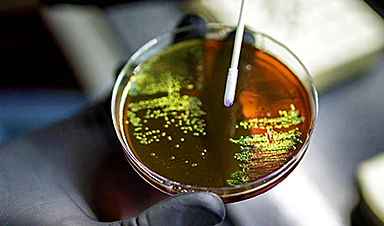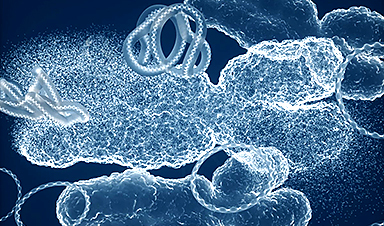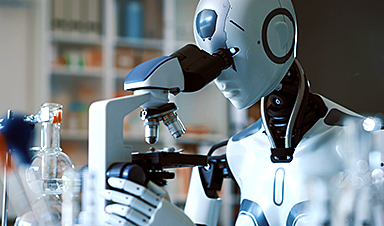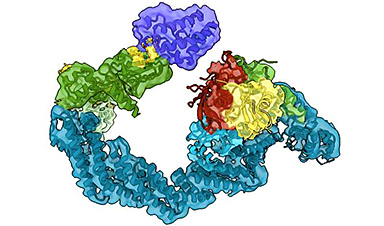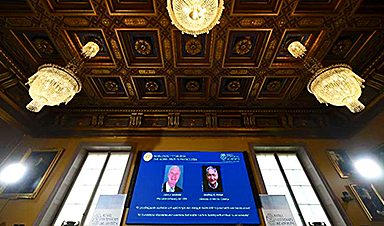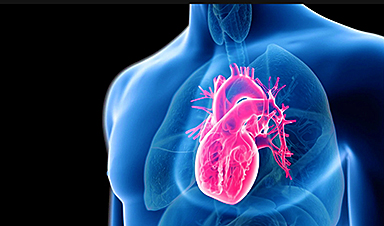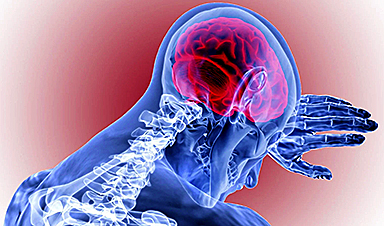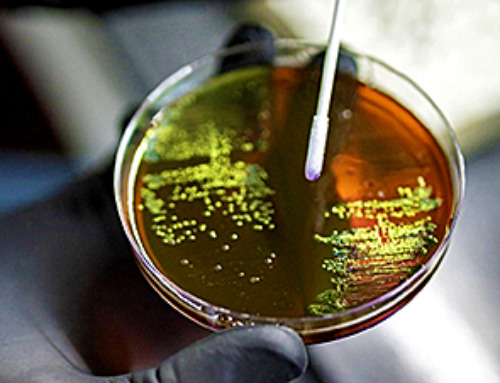Harnessing nanoparticles to deliver drugs precisely to a surgically repaired tendon is a promising new approach that reduced scar tissue formation and improved mechanical function. Researchers’ success in pinpointing a drug therapy inside the body, at the cellular level, proved to be a highly efficient delivery method that could be used to treat other injuries. Their study is published in Science Advances.
Whether it’s a season-ending Achilles rupture by pro footballer Aaron Rodgers or an everyday workplace accident, tendon injuries are common and can be life-changing. They require 300,000 surgeries per year and often result in lost work time and permanent impaired physical function.
Typically, traumatic tendon injuries are surgically repaired with sutures, but optimal healing is often impaired by the tendon’s propensity to heal with scar tissue that restricts tendon movement and function.
Researchers at the University of Rochester and University of Oregon combined their expertise in tendon cell biology and drug delivery systems to find a better way to deliver therapies that can reduce scar tissue and facilitate improved healing.
“There are very few effective drug regimens to assist the tendon healing process, despite the high number of these injuries and the poor outcomes that often result,” said Alayna Loiselle, Ph.D., associate professor at the University of Rochester’s Center for Musculoskeletal Research.
“Systemic drug treatments delivered orally or via injection show poor tendon homing; in some cases, less than 1% of a systemically delivered medication reaches the healing tendon. Local administration of drugs directly to the tendon has disadvantages as well, including potential tissue damage from the injection and poor control over drug concentrations at the point of injury.”
“We want to pivot from using suturing alone to incorporating therapeutics,” said Emmanuela Adjei-Sowah, a Biomedical Engineering Ph.D. student at the University of Rochester, who has spent the past several years working with co-authors Loiselle, Danielle S.W. Benoit, Ph.D., and others to develop the nanoparticle delivery system to improve healing in tendon injuries. “Advances in multiomics and drug delivery using nanoparticles open up new possibilities in treatment.”
The challenge for researchers was to identify which substances could assist tendon healing.
Molecular ‘map’ of healing process charts a new therapeutic path
“The fundamental cellular and molecular mechanisms that drive scar-mediated tendon healing are really only just beginning to be well-defined,” Loiselle said. “Our prior work used spatial transcriptomic profiling to define a molecular map of the healing tendon. In subsequent analysis of this data, we found that the area right at the injury site had high levels of Acp5 gene expression, which was both surprising and exciting.”
The Acp5 gene produces a protein called Tartrate Resistant Acid Phosphatase (TRAP); both are known to occur as injured bones recover and rebuild. High TRAP activity within the healing tendon allowed researchers to employ a peptide that binds with TRAP to deliver medication directly to the healing tendon site.
“While Benoit’s lab has previously used TRAP-binding peptide nanoparticles (TBP-NP) for targeted drug delivery to bone, high TRAP activity in the healing tendon opened up an entirely new research direction,” Loiselle said.
Prior to initiating studies with therapeutic agents, the team completed a series of dose and timing studies, using a mouse model of complete transection and surgical repair of the flexor tendon, to define the window in which their drug delivery system could most effectively target the healing tendon.
“Defining an optimal treatment window is critical to successfully developing an innovative and effective drug delivery system that improves tendon healing by encouraging a more regenerative, rather than fibrotic, healing cascade,” said Benoit, the Lorry Lokey Department Chair and Professor in the Department of Bioengineering at the University of Oregon.
“In addition, by defining the optimal therapeutic window for this drug delivery system, we can mitigate the unwanted side effects that typically accompany the high doses or multiple doses required to achieve sufficient drug accumulation in the tissue.”
As a therapeutic, the team chose Niclosamide, which inhibits S100a4, a protein that Loiselle’s lab already identified as contributing to scar formation. Previous work from Loiselle’s lab demonstrated that genetic knockdown of S100a4 improved mechanical and functional outcomes in this mouse tendon healing model.
S100a4 has been implicated in scar formation in many tissues, including the liver, heart, lung, and oral submucosa; Loiselle’s discovery that it complicates tendon healing gave them a therapeutic target for this study, where they used their TRAP-binding peptide nanoparticle drug delivery system to precisely affect the injured tendon.
As a comparison, they delivered Niclosamide systemically; it did slightly reduce the amount of S100a4 in the healing tendon but it had no beneficial impact on the healing process. In contrast, delivery of the same dose of Niclosamide using the nanoparticle system resulted in robust inhibition of S100a4 mRNA and protein levels in the healing tendon.
This targeted drug delivery method also significantly benefited the tendon healing process. TBP-NP delivery of Niclosamide improved both functional range of motion recovery and increased the mechanical integrity of the healing tendon across both short- and longer-term timepoints. Importantly, these sustained effects occurred with just a single treatment.
Researchers will continue their work to define how broadly the system can be used for other tendon injuries and disease, as well as other types of tissue injury that result in scar formation.
“The beauty of this system is that it can be loaded with different kinds of drugs to target different molecular processes or pathways,” said Adjei-Sowah.
More information: Emmanuela Adjei-Sowah et al, Development of a nanoparticle-based tendon-targeting drug delivery system to pharmacologically modulate tendon healing, Science Advances (2024). DOI: 10.1126/sciadv.adn2332
Journal information: Science Advances
Provided by University of Rochester Medical Center
News
Scientists Have Discovered Toxic “Forever Chemicals” in Bottled Water
Scientists have found toxic PFAS in drinking water samples from around the world, with higher levels in tap water from China compared to the UK. Boiling water or using a filtration jug can reduce [...]
Urban Microbes Are Eating Disinfectants – Are We Fueling a New Health Threat?
New research reveals that microbes in urban environments are evolving to withstand the very cleaning agents designed to eliminate them. The study also uncovers new strains in Hong Kong, previously only found in the [...]
Startling Study Shows High-Potency Cannabis Alters DNA
The study shows that frequent use of high-potency cannabis alters DNA, affecting genes related to energy and immune function. These changes differ between those with and without psychosis, suggesting cannabis use could influence mental health through biological [...]
New nanotherapy targets artery inflammation in cardiovascular disease
Inflammation of the arteries is a primary precursor and driver of cardiovascular disease—the No. 1 killer of people in the United States. This inflammation is associated with the buildup of dangerous plaque inside the [...]
Revolutionary Nanoparticle Therapy for Prostate Cancer
A groundbreaking research effort involving teams from the University of Virginia, Mount Sinai, the University of Michigan, the University of Texas, and others has displayed the clinical efficacy of an innovative therapy that utilizes nanoparticles and [...]
Antibody engineering drives innovation in drug development
Monoclonal antibodies (mAbs) are used to prevent, detect, and treat a broad spectrum of non-communicable and communicable diseases. Over the past few years, the market for mAbs has grown exponentially with an expected compound [...]
Breakthrough Study Reveals How Bladder Cancer Starts and Spreads
Researchers found that DNA mutations from antiviral enzymes and chemotherapy fuel early bladder cancer, while abnormal circular DNA in tumor cells drives resistance to therapy. These discoveries open new therapeutic avenues. A groundbreaking study led by [...]
AI and Quantum Mechanics Accelerate Drug Discovery
A recent article published in the Journal of Chemical Information and Modeling researchers at Southern Methodist University (SMU) have developed SmartCADD, an open-source virtual tool designed to speed [...]
Targeting ‘undruggable’ diseases: Researchers reveal new levels of detail in targeted protein degradation
Researchers at the University of Dundee have revealed in the greatest detail yet the workings of molecules called protein degraders which can be deployed to combat what have previously been regarded as "undruggable" diseases, [...]
Revolutionizing Virology: AI Discovers Over 160,000 New RNA Viruses
Largest discovery of new virus species sheds light on the hidden virosphere. Artificial intelligence (AI) has been used to reveal details of a diverse and fundamental branch of life living right under our feet and in every [...]
Cardiac Crisis: COVID-19 Doubles Risk of Heart Attacks, Strokes, and Death
Research indicates that COVID-19 survivors face doubled risks of severe cardiac events for years after recovery, especially if hospitalized. People with A, B, or AB blood types are particularly vulnerable, highlighting the need for personalized approaches [...]
AI steps into science limelight with Nobel wins
For long periods of its history, artificial intelligence has lurked in the hinterland of science, often unloved and unfunded—but two Nobel prizes in one week suggest its time in the sunshine has finally arrived. [...]
MIT Scientists Shed New Light on the Critical Brain Connections That Define Consciousness
A new study provides further evidence that consciousness depends on communication between the brain’s sensory and cognitive regions in the cortex. Our brains are constantly making predictions about our surroundings, enabling us to focus [...]
Common Chemicals Found in Shampoo and Plastic Could Be Quietly Disrupting Your Heart’s Rhythm
UC study of Fernald data links environmental phenols to heart toxicities Environmental phenols are present in numerous everyday consumer products, serving as preservatives in packaged foods, parabens in shampoos, and bisphenol A (BPA) in [...]
Revolutionary Brain Tech Offers New Hope for Stroke and Injury Recovery
University of Pittsburgh researchers report that deep brain stimulation (DBS) can effectively enhance motor functions in individuals with arm and hand paralysis due to brain injuries, with promising results from early human and monkey [...]
NIH Scientists Discover Gene Responsible for Rare Eye Disease
Findings supported by the NIH pave the way for the development of genetic testing, clinical trials, and therapies. Researchers at the National Institutes of Health (NIH) and their collaborators have discovered a gene linked to certain [...]


